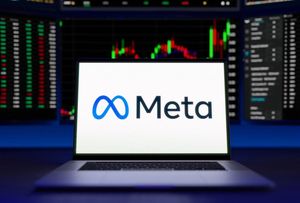
As October 2025 unfolds, the stock market continues its remarkable and, for many, perplexing upward trajectory. Major indices have repeatedly scaled new peaks, leaving many investors and analysts to ponder the underlying forces propelling this seemingly unstoppable rally. This sustained bullish momentum is a multifaceted phenomenon, rooted in a resilient economic landscape, the transformative power of artificial intelligence, robust corporate earnings, and a prevailing wave of investor optimism, all underpinned by strategic monetary policy shifts and anticipated governmental actions.
This continuous ascent has profound implications, not only for individual investors but for the entire financial ecosystem. Public companies are experiencing varying degrees of benefit, with some sectors riding the wave of innovation and economic strength, while others face the challenges of elevated valuations and potential market shifts. Understanding the intricate dynamics at play is crucial for navigating what comes next in this extraordinary market environment.
The Engines of Growth: A Deep Dive into the Market's Relentless Climb
The current market rally is no accident; it is the culmination of several powerful drivers, both economic and technological, that have converged to create a uniquely bullish environment.
Economically, the U.S. has demonstrated remarkable resilience. Despite earlier fears of a sharper downturn, real GDP growth maintained a healthy pace through 2023 (2.9%) and 2024 (2.8%), with projections for 2025 showing a more moderate but still positive expansion. Inflation, while showing some stickiness and hovering around 3% in 2024 and early 2025 (above the Federal Reserve's 2% target), has largely moderated from its 2022 highs. This moderation allowed the Federal Reserve to initiate a series of interest rate cuts starting in September 2024, bringing the federal funds rate down to 4.25%-4.50% by year-end 2024, with further cuts anticipated throughout 2025. These lower borrowing costs are stimulating economic activity and making equities more attractive relative to bonds. Furthermore, a resilient labor market and stable consumer spending have continued to underpin economic strength, providing a solid foundation for corporate performance.
The most significant catalyst, however, has been the transformative power of Artificial Intelligence (AI). The AI boom, sparked by the late 2022 launch of ChatGPT, has ignited a global "arms race" in technological innovation. Total AI investments in the U.S. alone surged to $109.1 billion in 2024, with the global AI market projected to expand by 38% in 2025. AI is not merely a buzzword; it is a tangible force driving productivity and growth across industries. Tech giants like Microsoft (NASDAQ: MSFT), Meta Platforms (NASDAQ: META), and Alphabet (NASDAQ: GOOGL) have aggressively leveraged AI to optimize operations and drive substantial revenue growth, with Microsoft planning approximately $80 billion for AI-enabled data centers in fiscal year 2025. This massive infrastructure spending has also created a "picks and shovels" boom, particularly benefiting semiconductor and hardware companies.
Corporate earnings have been exceptionally strong, providing fundamental justification for rising stock prices. The S&P 500 demonstrated robust earnings growth throughout 2024, with Q1 2025 earnings growing by 10% and beating expectations by nearly 6% across all sectors. The estimated earnings growth rate for Q3 2025 is 8.0%, with expectations to report above 13%, marking the ninth consecutive quarter of year-over-year growth. While the "Magnificent Seven" tech stocks initially led much of these gains, market participation has broadened in late 2024 and into 2025, with industrials, healthcare, financials, and materials sectors also showing strong performance. This broadening suggests a healthier, more diversified rally. Investor sentiment has remained largely optimistic, fueled by confidence in strong company fundamentals and stable economic data, with increased risk appetite evidenced by surging interest in various asset classes.
Adding to this bullish cocktail are specific policy shifts and anticipations. The Federal Reserve's rate cuts have provided a direct tailwind. Furthermore, following the U.S. election, an anticipated "Trumponomics" rally has emerged, driven by expectations of business-friendly initiatives from the incoming administration. These include potential lower corporate tax rates (from 21% to 15%, which could boost S&P 500 earnings by 5 percentage points) and deregulation across sectors like banking, energy, and healthcare. Continued government spending from initiatives like the Infrastructure Act, with funding contractually obligated through 2026, also continues to benefit sectors like industrials.
Winners and Losers: Corporate Fortunes in a Bull Market
In a market defined by such powerful trends, the impact on public companies is starkly divided, creating clear winners and potential laggards.
The most prominent winners are undeniably the technology companies at the forefront of the AI revolution. Semiconductor manufacturers like NVIDIA (NASDAQ: NVDA), which designs the crucial chips for AI processing, continue to see unprecedented demand and soaring valuations. Cloud computing providers, including Amazon's (NASDAQ: AMZN) AWS and Microsoft's (NASDAQ: MSFT) Azure, are also massive beneficiaries as companies pour capital into AI infrastructure. Software companies integrating AI into their products, such as Adobe (NASDAQ: ADBE) and Salesforce (NYSE: CRM), are enhancing their offerings and driving subscription growth. These companies are not just seeing increased revenue; they are also benefiting from enhanced productivity and operational efficiencies that AI brings to their own operations. Their robust earnings growth and future potential are heavily factored into their stock prices, often leading to elevated valuations.
Beyond the immediate tech sphere, the broadening market rally has brought gains to other sectors. Industrials are benefiting from ongoing infrastructure spending and a generally strong economic environment. Healthcare companies, particularly those leveraging AI for drug discovery and diagnostics, are also experiencing growth. Financials are seeing improved lending conditions as interest rates normalize and economic activity remains strong. Companies in the materials sector are gaining from increased demand for raw inputs driven by manufacturing and infrastructure projects. Many of these companies are also actively adopting AI to streamline operations, enhance customer service, and innovate product development, further boosting their competitive edge and profitability.
However, not all companies are positioned to win equally, and some face significant challenges. Companies that are slow to adopt AI or whose business models are disrupted by AI-driven innovation may find themselves losing market share and struggling to maintain profitability. Traditional businesses with high operating costs or those heavily reliant on manual processes could face pressure as AI-enabled competitors gain efficiency. Furthermore, companies with already high debt levels might find the transition to a new rate environment challenging, even with rate cuts, if their business models are not robust enough to capitalize on the broader economic strength. Elevated valuations across the market also mean that companies with weaker fundamentals or less compelling growth stories might see their stock prices stagnate or even decline if investor sentiment shifts or if they fail to meet lofty expectations. The potential for an "AI bubble" also poses a risk, where companies with promising but unproven AI strategies could see their valuations corrected if profitability doesn't materialize as quickly as anticipated.
Broader Implications: A Shifting Economic Landscape
The persistent stock market rally is more than just a financial phenomenon; it is reshaping broader industry trends, influencing regulatory discussions, and drawing comparisons to historical market cycles.
This rally fits into a larger narrative of technological disruption and economic restructuring. The AI revolution is not just impacting the tech sector; it is fundamentally altering business models across every industry, from manufacturing and logistics to healthcare and finance. Companies that embrace AI for automation, data analysis, and personalized customer experiences are gaining a significant competitive advantage, potentially leading to increased market concentration in the hands of early adopters and innovators. This trend could create ripple effects, forcing competitors to accelerate their own AI investments or risk obsolescence. Strategic partnerships are also emerging, with established enterprises collaborating with AI startups to integrate cutting-edge technologies.
Regulatory and policy implications are significant. Governments worldwide are grappling with how to regulate AI to ensure ethical development, data privacy, and prevent monopolistic practices. Antitrust concerns surrounding the dominant tech players, especially those leading the AI charge, are likely to intensify. The anticipated "Trumponomics" policies, particularly potential corporate tax cuts and deregulation, could further fuel corporate profits and investment, but also raise questions about fiscal deficits and wealth distribution. The push for domestic manufacturing and supply chain resilience, often intertwined with advanced automation and AI, could also lead to new industrial policies and trade dynamics, potentially impacting global trade relations, especially with countries like China.
Historically, periods of rapid technological advancement have often been accompanied by significant market rallies, sometimes leading to speculative bubbles. The current environment draws parallels to the dot-com boom of the late 1990s, where optimism about the internet's potential fueled exponential growth in tech stocks. However, proponents argue that today's AI advancements are backed by more tangible productivity gains and broader enterprise adoption, suggesting a more sustainable growth trajectory. Nevertheless, the discussions about a potential "AI bubble" are growing on Wall Street, with concerns about climbing valuations for private AI companies and questions regarding clear paths to profitability for some. The market's current concentration in a few dominant tech companies also echoes past eras, raising questions about overall market health and diversification.
What Comes Next: Navigating the Future Market
Looking ahead, the stock market's trajectory will be shaped by a combination of ongoing trends, potential policy shifts, and emerging challenges. Both short-term fluctuations and long-term structural changes are on the horizon.
In the short term, the market will closely watch the Federal Reserve's actions regarding further interest rate cuts. While more cuts are expected, persistent inflation above target could limit the Fed's flexibility, potentially dampening investor enthusiasm. Corporate earnings reports, particularly from the major tech players, will continue to be critical barometers of market health. Any signs of a slowdown in AI monetization or a miss on earnings expectations could trigger volatility. Geopolitical developments, such as ongoing conflicts in Ukraine and the Middle East, or escalating trade tensions (especially with China, which has already halted a stock rally in October 2025 affecting AI chip companies), also pose immediate risks that could agitate markets. The implementation of anticipated "Trumponomics" policies, particularly tax reforms, will be a key focus, as their precise impact on corporate profits and investor sentiment unfolds.
Longer term, the continued evolution and widespread adoption of AI will be the dominant theme. We may see a shift from the initial "picks and shovels" phase, where hardware and infrastructure providers benefit most, to a broader phase where AI-enabled software and services drive productivity gains across all sectors. This could lead to a re-evaluation of valuations, favoring companies that can demonstrate clear and scalable profitability from their AI investments. Market opportunities will emerge in sectors that successfully integrate AI to create new products, optimize supply chains, and enhance customer experiences. However, challenges such as regulatory scrutiny, the need for skilled AI talent, and the ethical implications of advanced AI will also need to be addressed. The potential for two AI cycles—an initial advertising-driven consumer AI cycle followed by a pullback before a longer enterprise AI cycle—is a scenario investors should consider.
Strategic pivots will be essential for companies aiming to thrive. Businesses that adapt quickly to AI-driven changes, invest in upskilling their workforce, and focus on sustainable innovation will likely outperform. Investors should anticipate potential strategic adaptations, such as increased M&A activity as larger companies acquire innovative AI startups, or divestitures of non-core assets to focus on AI-centric growth. Potential scenarios range from a continued, albeit more moderate, bull run fueled by sustained AI-driven productivity, to a significant market correction if AI valuations prove unsustainable or if unforeseen economic shocks occur. The resilience of consumer spending and the stability of the labor market will also play crucial roles in determining the overall health of the economy and, by extension, the stock market.
A Comprehensive Wrap-Up: Navigating a Dynamic Market
The stock market's persistent upward trend into late 2025 is a testament to the powerful confluence of technological innovation, economic resilience, and strategic policy actions. The AI revolution stands out as the primary catalyst, driving unprecedented investments and productivity gains across industries, with companies like NVIDIA (NASDAQ: NVDA), Microsoft (NASDAQ: MSFT), and Amazon (NASDAQ: AMZN) at the forefront. Coupled with a resilient U.S. economy, strong corporate earnings (which have broadened beyond the "Magnificent Seven"), and supportive monetary policies from the Federal Reserve, the market has found ample reason to climb.
Moving forward, investors must remain vigilant. While the fundamental drivers appear robust, underlying risks such as elevated valuations, the potential for an "AI bubble," persistent inflation, and geopolitical instability cannot be ignored. The anticipated policy shifts under a new U.S. administration, particularly regarding corporate taxes and regulation, will also play a significant role in shaping the market landscape. The market's current concentration in a few dominant tech companies, despite a recent broadening, still warrants attention.
In the coming months, investors should closely watch for continued corporate earnings strength, particularly how companies outside the immediate tech sector integrate and monetize AI. The pace and impact of Federal Reserve interest rate cuts, and any signs of inflation persistence, will be critical. Furthermore, monitoring geopolitical developments and the actual implementation of new government policies will be key to understanding potential market shifts. While the current environment presents exciting opportunities, a balanced and informed approach, with a keen eye on both the immense potential of AI and the inherent risks of an elevated market, will be paramount for successful investing.
This content is intended for informational purposes only and is not financial advice





